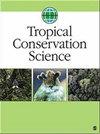再生地点的意外多样性强调基线的重要性:以哥斯达黎加奥萨半岛的蝙蝠(翼目)为例
IF 1.6
4区 环境科学与生态学
Q2 BIODIVERSITY CONSERVATION
引用次数: 0
摘要
背景与研究目的:生物多样性恢复评估是确定生境恢复保护目标是否实现的关键。许多恢复计划使用野生动物群落的横断面比较来推断恢复影响,而不是从基线状态进行纵向评估。利用新热带生物多样性的一个指标——蝙蝠,我们展示了如何在实施之前评估恢复目标地区的群落多样性和组成,并将其与周围完整的森林进行比较,为跟踪恢复后群落的变化提供了基础。方法采用雾网法鉴定叶鼻蝠科(Phyllostomidae)种,采用声学法鉴定非叶鼻蝠科(air -食虫动物)种。结果两种生境类型的群落多样性与周围森林相似,但群落组成存在差异。在森林中以较高的捕获率捕获到根茎类昆虫,而在恢复生境中以较高的捕获率捕获到空中食虫动物。结论我们的基线评估揭示了修复目标地区意想不到的多样性。恢复生境中所有营养类群的存在表明,蝙蝠在恢复过程中提供了关键的生态系统服务,例如通过种子传播、授粉和害虫控制。保护意义:对恢复目标地区的蝙蝠进行基线调查表明,该群落在基线时物种并不匮乏,而且与周围森林不同,这使我们能够更好地跟踪恢复成功和不同恢复措施的效果。本文章由计算机程序翻译,如有差异,请以英文原文为准。
Unexpected Diversity in Regenerating Sites Stresses the Importance of Baselines: A Case Study With Bats (Order Chiroptera) on the Osa Peninsula, Costa Rica
Introduction: Background and Research Aims: Assessing biodiversity recovery is key to determine whether the objectives of habitat restoration for conservation are met. Many restoration initiatives use cross-sectional comparisons of wildlife communities to infer restoration impact instead of longitudinal assessments from a baseline state. Using an indicator of biodiversity in the neotropics— bats— we demonstrate how assessing community diversity and composition in an area targeted for restoration prior to implementation, and when compared to surrounding intact forest, provides the groundwork to track changes in the community post-restoration. Methods We assessed bat communities by 1) using mist-net surveys to identify species in the family Phyllostomidae (leaf-nosed bats), and 2) conducting acoustic surveys to identify non-phyllostomid species (aerial insectivores). Results For both groups, we found that areas targeted for restoration had similar diversity as the surrounding forest, but the two habitat types differed in community composition. Phyllostomids were captured at higher rates in forest, but aerial insectivores were detected at higher rates in restoration habitat. Conclusion Our baseline assessment revealed unexpected diversity in areas targeted for restoration. The presence of all trophic groups in restoration habitat suggests that bats provide key ecosystem services in the restoration process, such as through seed dispersal, pollination and insect pest control. Implications for Conservation: Conducting a baseline survey of bats in areas targeted for restoration demonstrated that the community was not species poor at the baseline and was different from the surrounding forest, allowing us to better track restoration success and the effects of different restoration treatments.
求助全文
通过发布文献求助,成功后即可免费获取论文全文。
去求助
来源期刊

Tropical Conservation Science
BIODIVERSITY CONSERVATION-
CiteScore
3.60
自引率
5.90%
发文量
16
审稿时长
>12 weeks
期刊介绍:
Tropical Conservation Science is a peer-reviewed, open access journal that publishes original research papers and state-of-the-art reviews of broad interest to the field of conservation of tropical forests and of other tropical ecosystems.
 求助内容:
求助内容: 应助结果提醒方式:
应助结果提醒方式:


